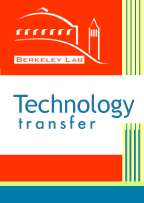|
|
 |
|
 |
| |
AVAILABLE
TECHNOLOGIES |
 |
| |
|
|
| |
Low-resistivity Photon-transparent Window Attached to Photo-sensitive Silicon Detector
IB-1204
|
|
 |
|
|
| |
|
|
|
|
APPLICATION
OF TECHNOLOGY:
- Medical
Imaging
- Other
Digital Scanning technologies
ADVANTAGES:
- Inexpensive and efficient
- High quantum efficiency without thinning
- Backlighting in the blue wavelenths; improved red wavelength
performance
- Ease of fabrication
|
 |
|
LBNL 4-side abutable packaging of a 2kx4k 15 um pixel CCD
The CCD (bottom, front side up, toward assembly) is bonded to an aluminum nitride circuit board. Wire bonds connect the pads on the cantilevered edges of the CCD to the circuit board. The molybdenum block is bonded to a "naked" area of the circuit board. Threaded holes serve for handling the assembly and securing it to the cold plate. Indexing pins are aligned with the CCD during assembly. |
|
|
|
PATENT ABSTRACT:
Stephen Holland at Berkeley Lab has developed an invention that comprises a combination of a low resistivity, or electrically conducting, silicon layer that is transparent to long or short wavelength photons and is attached to the backside of a photon-sensitive layer of silicon, such as a silicon wafer or chip. The window is applied to photon sensitive silicon devices such as photodiodes, charge-coupled devices, active pixel sensors, low-energy x-ray sensors and other radiation detectors. The silicon window is applied to the back side of a photosensitive silicon wafer or chip so that photons can illuminate the device from the backside without interference from the circuit printed on the frontside. A voltage sufficient to fully deplete the high-resistivity photosensitive silicon volume of charge carriers is applied between the low-resistivity back window and the front, patterned, side of the device. This allows photon-induced charge created at the backside to reach the front side of the device and to be processed by any circuitry attached to the front side. Using the inventive combination, the photon sensitive silicon layer does not need to be thinned beyond standard fabrication methods in order to achieve full charge-depletion in the silicon volume. In one embodiment, the inventive backside window is applied to high resistivity silicon to allow backside illumination while maintaining charge isolation in CCD pixels. |
|
|
|
STATUS:
U.S. Patent #6,025,585.
Available for licensing in all fields of use, including use for positron emission tomography, as well as x-ray imaging of all kinds, with the exception of the field of photodiodes to perform single photon nuclear medicine procedures.
|
|
|
|
REFERENCE
NUMBER: IB-1204
|
|
|
SEE THESE OTHER BERKELEY LAB TECHNOLOGIES IN THIS FIELD:
|
|
|
FOR
MORE INFORMATION PLEASE SEE:
|
|
|
| |
|
|
CONTACT:
|
Technology
Transfer Department
E.O. Lawrence Berkeley National Laboratory
MS 90-1070
Berkeley, CA 94720
(510) 486-6467 FAX: (510) 486-6457
TTD@lbl.gov |
|
|
| |
|
|
| |
|
|
|



